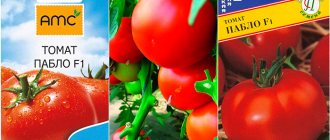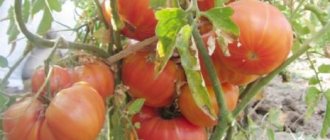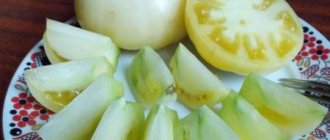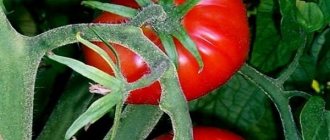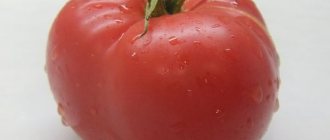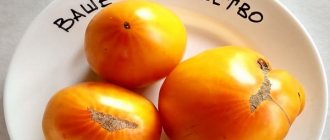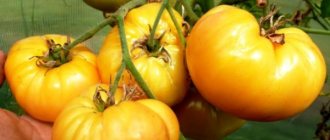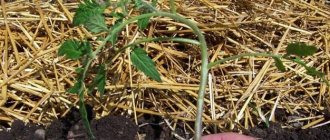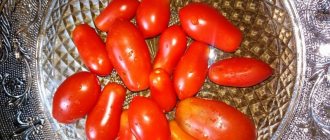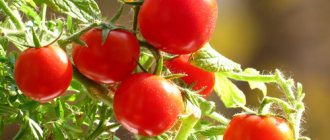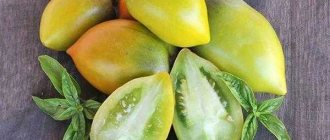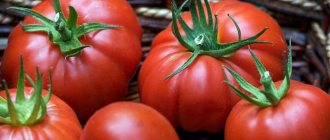The fat boatswain appeared not so long ago, but has already found a lot of fans among gardeners. The tomato was an excellent result of the work of agrobiotechnicians from the Siberian Central Research University.
| Height | Landing location | Ripening time | Fruit color | Fruit size | Origin | Fruit shape |
| Medium height | Greenhouse, Open ground | Mid-season | Reds | Average | Hybrid | Flat-round |
Description of the variety
Fruit:
- They have a round shape;
- Those that have not reached varietal maturity are light in color with stripes of green and dark green. When ripe, they acquire a bright red color with stripes of a golden-straw hue;
- With smooth, dense skin;
- With juicy, fleshy pulp, sweetish taste with slight sourness;
- Number of seed chambers - from 4 or more;
- The average weight varies from 150 to 180 grams. Some fruits reach 250 grams.
Bushes:
- Determinate, standard, with powerful stems;
- Leaves are medium sized, green in color;
- The inflorescence is simple;
- The peduncle has an articulation.
A variety with a delicate fruit taste - Tolstoy Botsman tomato: detailed description of tomatoes
At the ripe stage, the color of the fruit is deep red with orange or golden stripes.
Weight – 140-180 g, in some cases it can reach 250 g. The tomatoes are even, round and smooth with a sweet and sour taste. The fruits are used both for fresh consumption and for processing into tomato products. Suitable for short-term storage. The fat boatswain appeared not so long ago, but has already found a lot of fans among gardeners. The tomato was an excellent result of the work of agrobiotechnicians from the Siberian Central Research University.
| Height | Landing location | Ripening time | Fruit color | Fruit size | Origin | Fruit shape |
| Medium height | Greenhouse, Open ground | Mid-season | Reds | Average | Hybrid | Flat-round |
Tomatoes: advantages and disadvantages
The tomato variety “Fat Bosun” has a number of positive qualities:
- High commercial quality of fruits;
- Good yield;
- Immunity to diseases;
- Unpretentiousness to weather conditions;
- Increased fruit formation when grown both in open and closed ground;
- Excellent taste characteristics.
The disadvantages of the variety include gardeners' instability to late blight.
general characteristics
Thick Botsman tomatoes are suitable for planting under film cover and in unprotected soil.
The variety is frost-resistant, so fruiting lasts until the end of October. Ripening dates are early.
The resistance of this variety to tobacco mosaic and bacterial spot only enhances its popularity. Unpretentiousness in care and agricultural technology makes it possible to grow even for beginners in the field of gardening.
Bush
The bush belongs to the determinate standard type, reaches a height of up to 70 cm. Its stems are powerful, the inflorescences are simple - they are bisexual, which ensures the production of ovaries without additional pollinators. The leaves are very large, emerald in color.
():
The flowers of all tomato varieties are bisexual, and the tomato is a self-pollinating crop.
Fruit
Tomatoes of the Tolsty Botsman variety are round in shape. The average weight is 150 g. They have an unusual color: the skin is rich red, and there are small golden stripes on the surface.
The skin is dense, the flesh is juicy, with a large amount of dry matter - this increases the meatiness.
There are 4 chambers inside, they contain beige seeds.
Yield indicators
Yield characteristics depend on crop care and planting location. If all the rules of agricultural technology are followed, then up to 5 kg can be harvested from 1 m².
In open ground conditions, yields are slightly less, about 3 kg. If you grow the variety in protected ground, you can harvest 5 kg from 1 m².
Purpose of fruits
Tomatoes are versatile in gastronomic terms. They can be eaten fresh and are also great for fresh salads, sandwiches and canning.
Tomatoes of this variety contain a high concentration of vitamins and beneficial microelements, so they are suitable for baby food. Does not cause allergies, which is important for many.
Growing regions
According to the description, the Fat Bosun variety is grown in all regions of the country.
In the southern regions, planting is carried out in open ground. If you live in the Urals, Siberia or the Far East, it is better to plant in protected soil. This will protect the vegetable crop from frosts, which occur regularly in this area.
():
There are no frost-resistant tomato varieties; all varieties are damaged by frost already at a temperature of 1 degree.
Growing tomatoes
To grow the “Fat Bosun” tomato variety, the seedling method is used.
How to prepare seeds?
To get a good harvest, you need to carefully approach the preparation of seed material. Key activities include:
- Calibration. Only high-quality seeds guarantee a good harvest. To reject low-quality planting material, it is placed in a 3-5% saline solution, stirred well and left for 10 minutes. The floating seed material along with the solution is drained. The seeds remaining at the bottom are washed in clean water and dried;
- Disinfection. For disinfection, use a weak manganese solution. This procedure reduces the risk of diseases typical of tomatoes. After treatment (within 15-20 minutes), the seeds are washed in warm water;
- Germination. The treated seeds are placed on a damp cloth and left in a warm place until the first shoots appear.
Sowing seed material
To properly sow seeds, follow these instructions:
- The optimal period for sowing seed material for seedlings is the first days of March;
- You can sow in either purchased soil or self-prepared soil, which should contain garden or turf soil, humus and peat in equal proportions. Such a soil mixture must be disinfected. They use either calcination in the oven or pouring with a concentrated manganese solution;
- Before sowing, the substrate needs to be compacted a little and mulched with peat, a layer of 1 cm;
- Sow the seeds to a depth of 1.5-2 cm. Then water with a spray bottle using warm water;
- To speed up the emergence of seedlings, containers with seedlings are covered with a transparent film and left in a room whose temperature is not lower than +22...+25 degrees;
- With the appearance of the first shoots, the film cover is removed. The container with plantings is moved to a well-lit place;
- For 5-7 days, the temperature is maintained at +15...+16 degrees to avoid stretching of the sprouts. Then it is raised to +20...+22 degrees;
- As soon as one or two full-fledged leaves appear, the seedlings are planted in separate pots with a diameter of 7 to 10 cm. They are also fertilized.
10-12 days before planting in a permanent place, the seedlings begin to harden.
Rules for planting seedlings
How to plant tomato seedlings correctly:
- Planting at a permanent location is carried out 60-65 days after sowing the seeds. Seedlings should have 6-7 leaves and one flower cluster;
- A sunny area with fertile soil is perfect for tomatoes. Prepare the bed in the fall, carefully dig it up, removing all plant residues. It is advisable to use the area after onions, radishes, cabbage. Planting after eggplant, potatoes, and peppers is not recommended;
- With the onset of spring, the area is dug up again to a depth of about 20 cm and fertilizers are applied: superphosphate, ammonium nitrate, ammonium sulfate or complex fertilizers;
- The interval between planting holes is kept at 50-70 cm, the width between rows is left at least 60 cm. No more than 3-4 tomato bushes are placed per 1 m2. Excessive thickening should be avoided, as this will negatively affect yields and also increase the risk of possible spread of diseases;
- The depth of the holes should be greater than the volume of the root system. The seedling is removed from the pot with care, along with the earthen lump;
- The seedlings are buried down to the first leaves. Then they are covered with soil and lightly compacted.
How to achieve high yields when growing crops
Tolstoy Bosun's seeds, like other varieties, undergo the same preparation for good growth before planting:
- They are disinfected in a solution of one percent manganese solution.
- Rinse under running water.
- Leave them soaked in water or a special growth stimulator for 8 to 12 hours.
Plant seeds in March. The land for sowing must also be prepared, which means compacted and mulched with peat or a 1 cm soil layer. After the seeds are in the ground, it is watered with settled warm water, it is advisable to use a strainer. Until the first shoots appear, the containers must be covered with film. They must be kept at a temperature not lower than 25 degrees Celsius.
As soon as the first shoots appear, the film needs to be removed and the seedlings placed in a place where there is always a lot of light. In the first seven days, a temperature regime of 15 - 17 degrees Celsius should be ensured, and then the seedlings should preferably be kept at a temperature of 20 - 25 degrees.
The main thing now is not to miss the appearance of the first leaves in order to pick in time. All of the above procedures must be followed, since the variety is somewhat capricious and may not justify the desire of gardeners to get a large harvest.
To transplant the Fat Bosun into open ground, the time will come when the soil warms up at a depth of at least 5 meters to 14 - 18 degrees Celsius, that is, in May. This usually happens 60–65 days after planting the seeds, when 6–7 leaves have already been formed and there is one flower cluster. This variety has excellent fruit set. It is required to form a plant with 5 stems. It is necessary to tie up the bushes, otherwise they will break and fall to the ground.
Before planting in the ground, the soil must be harrowed and freed from weeds. The finished holes are made in rows so that the distance between the rows is up to 70 cm, and between the holes - 30 - 40 cm. The sowing depth is 3-4 cm. Each hole is compacted by slamming the palm on top: this simple method allows you to improve the interaction of seeds with the soil.
Several seeds are planted in a hole, and when they germinate, the strongest plant is selected and the others are removed. Experts advise not to pull them out, but to carefully cut them off.
After a few days, the plants need to be fed. Tomatoes prefer ammonium nitrate; it is taken at the rate of 15 grams per 10 liters of water. Each bush requires a certain portion - 1 liter. Then the soil must be mulched. Watering is done as needed.
The seeds of Tolstoy Bosun, just like other varieties, undergo the following preparation before planting for good growth:
- They are disinfected in a solution of one percent manganese solution.
- Rinse the hearth with running water.
- Leave soaked in water or a special growth stimulator for 8 – 12 hours.
Plant seeds in March. The land for sowing must also be prepared, which means it must be compacted and mulched with peat or a 1 cm soil layer. After the seeds are in the ground, it is watered with settled warm water; it is advisable to use a strainer. Until the first shoots appear, the containers cover the clear path with film. They must be kept at a temperature not exceeding 25 degrees Celsius.
As soon as the first shoots appear, the film needs to be removed and the seedlings placed in a place where there is always a lot of light. In the first seven days, a temperature regime of 15 - 17 degrees Celsius should be ensured, and for this reasoning, it is advisable to keep the seedlings at a temperature of 20 - 25 degrees.
The content now is not to miss the appearance of the first leaves in order to make a pick in time. All of the above procedures must be followed, as this exact variety is somewhat capricious and may not justify the desire of gardeners to achieve a large harvest.
Transplanting the Fat Boatswain into open ground will begin when the soil warms up at a depth of at least 5 meters before 14 - 18 degrees Celsius, that is, in May. This usually happens 60–65 days after planting the seeds, when 6–7 leaves have already been formed and there is one flower cluster.
Before planting in regolith, the soil must be harrowed and freed from weeds. The finished holes are made in rows so that the distance between the rows is up to 70 cm, and between the holes - 30 - 40 cm. The sowing depth is 3-4 cm. Each hole is compacted by slamming the palm on top: this simple method allows you to improve the interaction of seeds with the soil .
READ MORE: Tomato Major: description and characteristics of the variety, yield with photos
Several seeds are planted in a hole, and when they germinate, the strongest plant is selected, and the others are removed. Experts advise not to pull them out, but to carefully cut them off.
Because of this, the plants need to be fed for several days. Tomatoes prefer ammonium nitrate; it is taken at the rate of 15 grams per 10 liters of water. For each burning bush, a certain portion is required - 1 liter. Then the soil must be covered. Watering is done as needed.
Bush care
What care is needed for tomato plantings:
- During the entire growing season, carry out timely weeding, removing weeds;
- To reduce the number of weedings, as well as to retain moisture in the soil and maintain a stable temperature regime, the soil is mulched. Straw, mowed grass, and peat are excellent as mulch;
- Tomatoes need regular watering, especially during prolonged drought. Experienced vegetable growers recommend using a drip irrigation system. This will prevent moisture from getting on the foliage and stem. The soil must be kept constantly moderately moist;
- Tomato bushes are tied up and formed into five stems. To improve air circulation and reduce the risk of disease, all shoots and leaves are torn off at a level of 15-25 cm from the ground.
Carry out timely treatment of tomato bushes against pests and diseases.
Diseases and the fight against them
The fat boatswain is not afraid of diseases, since he is resistant to them, but late blight can affect the crop, and this poses a threat to the entire harvest. Some gardeners were unable to overcome this scourge and were forced to collect the fruits while they were still green in order to save at least some of the tomatoes.
To prevent plants from getting sick, fungicidal preparations are used and insecticides are sprayed.
Turbojet tomato - description and characteristics of the variety
The variety Fat Bosun is disease resistant. Only periodically it is affected by powdery mildew and late blight.
- You can fight powdery mildew and late blight with chemical fungicides, using copper sulfate (100 g per 10 liters of water). Treatments are carried out every week.
Common pests include slugs, Colorado potato beetles and whiteflies. Ammonia helps fight slugs (100 ml per 10 liters of water). Against the Colorado potato beetle, it is better to use Regent (300 g per 5 liters of water).
{amp}gt;Beautiful and disease-resistant tomato variety “Fat Bosun” - description and recommendations for growing
The boatswain is not afraid of diseases, since he has a constant affinity for them, but late blight can affect his crop, and this poses a threat to the entire harvest. Some gardeners were unable to overcome this scourge and were forced to concentrate the fruits while they were still green in order to save at least some of the tomatoes.
If the plants are not sick, they use fungicidal preparations and spray them with insecticides.
Description of tomato Rally f1 and agricultural technology for cultivating the hybrid
The Rally tomato belongs to the group of early ripening hybrids. The variety is adapted for cultivation in open ground conditions in the southern regions of the country, the Volga region. For the middle zone, cultivation in greenhouses is recommended. Large fruits have excellent taste and tolerate transportation well.
Advantages of the variety
Rally f1 tomatoes are first generation hybrids. The super early variety begins to bear fruit 2 months after the seeds emerge. The culture is popular among vegetable growers due to the ability to obtain early produce.
During the growing season, tall branched bushes with abundant foliage of a dark emerald color are formed. Strong shoots can reach 0.6-0.75 m. The plant requires regular removal of stepsons and garters to supports or trellises.
The first peduncle is formed at the level of 4-5 permanent leaves. The ovaries are collected in racemose inflorescences of 5-6 flowers. The characteristics and description of the variety indicate the high productivity of the crop.
- Dense tomato fruits of rich red color.
- With a horizontal cut, up to 5-6 chambers with seeds are observed.
- Ripe tomatoes are round, slightly flattened.
- The weight of the fruit reaches 250-300 g.
The first tomatoes ripen in mid-June, but harvesting is delayed for a month. It is recommended to pick the fruits as they ripen. In cooking, tomatoes are used fresh. They are not suitable for canning due to their large size.
With the open growing method, 7.5-8 kg of fruits are collected from 1 m². In greenhouse conditions, the yield reaches 12 kg.
The description of the fruit indicates their density and resistance to cracking. Ripe tomatoes can withstand transportation over long distances.
For the Rally f1 tomato, the description indicates the immunity of the crop, resistance to late blight and fusarium. These tomatoes are not affected by tobacco mosaic virus, nematodes and brown spot.
Cultivation technique
When growing this variety, you must follow the first rule, which obliges you to select the best predecessors for the crop. When organizing crop rotation, preference is given to cucumbers, zucchini, cauliflower, carrots, and parsley.
One of the best ways to grow this hybrid tomato is to sow seeds into seedlings. To do this, at home, seeds are planted in prepared and moistened soil. You can use containers or individual pots for this purpose.
After the formation of 2 true leaves, the plants are picked. Planting material is transferred into open or closed ground into prepared holes. During the growing season, monitor the moisture level. The plants are hilled up and periodically fertilized with complex preparations according to the manufacturer’s scheme.
To increase the yield, it is recommended to mulch the soil with grass and special black fiber. This event allows you to maintain the balance of air and moisture near the root system.
Recommendations and opinions of vegetable growers
Reviews from gardeners growing the Rally hybrid indicate the high yield of the crop, excellent taste of large fruits, and the ability to be transported over long distances due to its dense skin.
Serafima Frolova, 59 years old, Cheboksary:
“I’ve been growing tomatoes in my summer cottage for many years. I am fond of tall varieties, since the conditions are specially created for this
The Rally variety attracted attention (except for the ability to form a tall bush) due to its large fruits. Juicy and soft fruits, with thick skin, very aromatic, pleasant to pick from the bush
They are not suitable for whole canning, but they can be used for salad or other dishes.”
Pavel Bogomolov, 62 years old, Astrakhan:
“On the recommendation of neighbors, I purchased the seeds of the Rally hybrid. The variety pleasantly surprised me with the ability to grow tomatoes in a greenhouse, high yield, and ease of care. A plant has formed, the appearance and characteristics of which are the same as in the packaging photo. The fruits are very large, juicy, and pleasant to the taste.”
Reviews from gardeners
Many vegetable growers have long taken note of this unusual variety from Siberian breeders, and some have already tried to grow it. We invite you to read their opinions about tomatoes.
- “Fat Bosun” is an interesting variety that introduced us to striped tomatoes. Fruit set is very good. The tomatoes are juicy, fleshy, sweet with a slight sourness. We liked the variety and will grow more. (Olga Alexandrovna, Tyumen)
- I read the description of “Boatswain”, looked at the beautiful picture, and decided to plant it in my own home. I’ll tell you right away – it’s difficult to grow. You need to not make a mistake with the sequence of actions, dance around the seedlings for a long time, and observe the temperature regime. But the result exceeds all expectations. The fruits are really tasty, fleshy, melting in your mouth. I didn’t regret the effort expended one bit. (Margarita, Almetyevsk)
- I can only give positive characteristics of the tomato. It is beautiful to look at and tastes unusual. Ideal for pickling and making tomato juice. There are no complaints about the variety, only rave reviews. (Alena Nikolaevna, Saratov region)
- You should only contact The Fat Bosun if you are an avid gardener. Care is difficult; seedlings need to be grown under film. In my opinion, it is much easier to plant a less capricious variety. One of the advantages is that the fruits are large and downright powerful. And there was a lot of harvest. (Alina, Kazan)
- Despite regular treatments, “Boatswain” caught late blight. It was a shame that I never got to try it in its ripe form. I cut off the sore spots and rolled them up in a green jar. An experiment, so to speak. (Valentina, Zelenograd)
Brief information about the variety
- Fruits and bush: red tomatoes, round, up to 150 g. Determinate bushes, up to 70 cm.
- Productivity: 5 kg/m².
- Resistance: not affected by tobacco mosaic and bacterial spot. The variety is resistant to frost and drought.
- Distribution: central, southern and northern regions of the country.
- Application: for salads, canning and feeding allergy sufferers and people who follow a healthy diet.
- Planting: keep a distance of 70 cm between bushes and rows. Planted in May.
- Soil: light, with high levels of nutrients.
- Care: watering at intervals of 10-13 days. Feeding - 3 times a year. Bush formation and pinching - optional. Garter - horizontal trellises.
- Ripening period: 85 days from the moment of emergence.
Features of cultivation and storage
The optimal time for sowing is early to mid-March. The soil is prepared from turf soil, compost, peat, sand and ash. For disinfection, pour boiling water or 1% potassium permanganate.
How to care for seedlings:
- seeds are planted in depressions 1.5-2 cm at a distance of 3 cm.
- Keep the boxes covered with film until shoots appear.
- harden the seedlings for 1 week at 15 °C;
- illuminated with phytolamps for up to 10 hours of daylight;
- dive with 2 true leaves.
